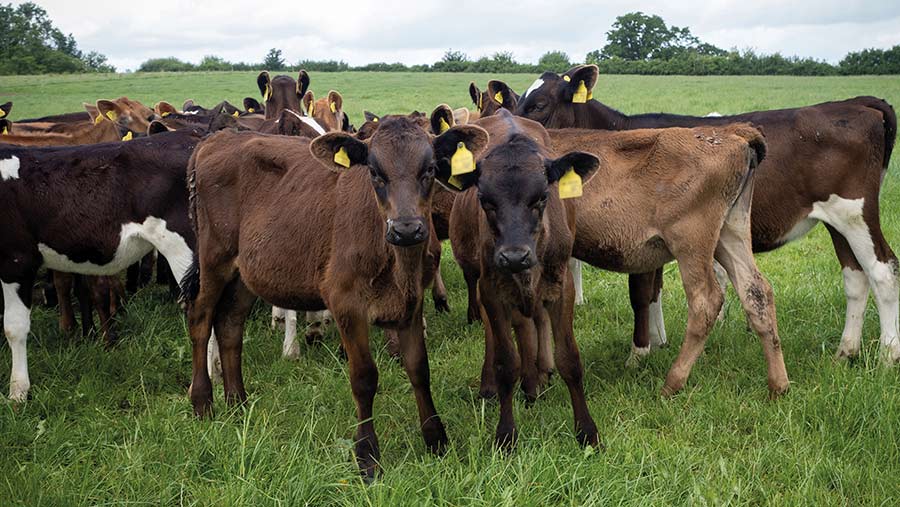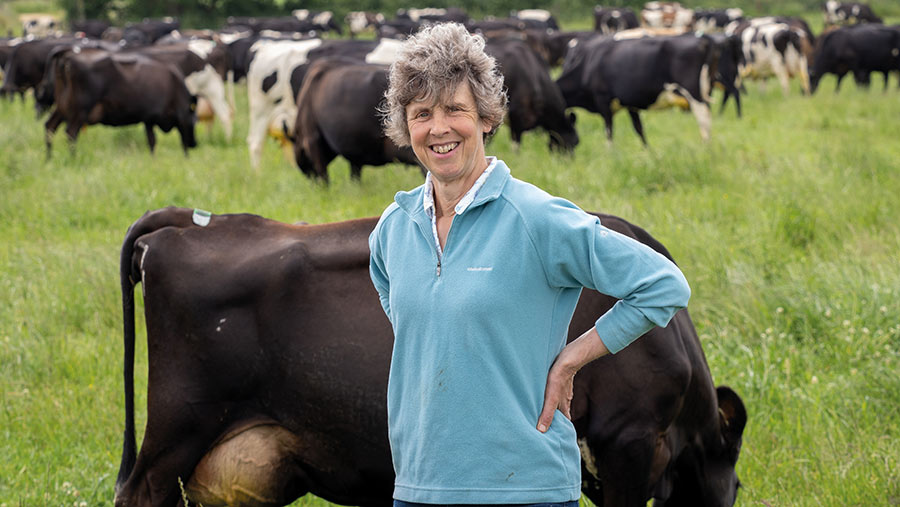12 tips on rearing heifers to last longer
 © Kathy Horniblow
© Kathy Horniblow More than 90% of the heifers born at Alford Fields, Somerset, have reached their second lactation in recent years. This means they can start paying back the cost invested into rearing them.
Known as “wastage from weaning to second calving” (WWSC), the number of heifers that fail to calve for a second time and start putting milk in the tank is standing at about 9%.
See also: Outsourcing heifer rearing: What you need to consider
Industry targets for WWSC are 15%, but we aim for 10% or less, which is achieved by focusing on heifers closely from birth.
Having just been shut up with TB, and aiming to be Johne’s-free, we are rearing about 90 heifers a year.
Farm facts
- 400 New Zealand Friesian cross Jersey cows
- Spring block-calving for nine weeks
- 210ha (520 acres) on a 10-year farm business tenancy
- Supply Barbers on a cheese contract
- Typically producing 475kg of milk solids a cow from 5,507 litres
- Winner of Farmers Weekly Dairy Farmer of the Year 2022
Rearing costs vary depending on the type of system and at what age the heifer first calves, but taking the standard industry figure of £1,500-£1,600 will mean payback is not achieved until the animal is well into her second lactation.
We maximise the number of heifer calves reaching second lactation in the following ways:
1. Vet visit and team involvement
- A pre-calving session with Friars Moor Vets and our five-person team last year went through the calving protocol.
- Changes discussed at the meeting included wellies being dipped in a cryptosporidium disinfectant before entering the calving pen, water drinkers installed on walls to minimise dung contamination and more lime on floors when cleaning out. These measures helped minimise disease and support liveweight gain.
2. Regular weighing of calves
- Every dairy heifer calf is weighed at birth on weigh scales. Average weight is 28kg, but small Jerseys can be 18kg and big Friesians can be 32kg.
- Regular weighing every two months identifies any calves under target weight. These are kept in a separate group and given grass and a 1kg of cake/day until they catch up, at which point they rejoin the main group.
- A “ready reckoner” calf weight chart is used to check on weights. The farm aims for 450kg at first calving and a mature cow weight of 500kg.
- Calves are ideally in one group by November, which makes outwintering easier.
3. Focus on colostrum
- Staff are trained to ensure each calf is fed with 2.5 litres of colostrum within three hours of birth.
- Two further 2.5-litre feeds are given for the following two days. Calves then go onto a 50% skimmed milk powder that is on the vet’s recommended list.
- This year the business has bought a refractometer to test colostrum quality and assess whether some frozen colostrum is needed.
4. Milk plan in place
- Milk replacer is fed at 2.5 litres twice a day, at a rate of 150g/litre, which is increased over the following week to 3 litres twice a day at 150g/litre.
- At this point, an 18% crude protein ad-lib calf cake is fed with ad-lib barley straw until the calves are 55-65kg (depending on birthweight).
- When they have reached this weight, they are gradually weaned over two weeks. By this point, they are typically eating 2-3kg of cake a day and gaining at 0.8kg a head a day.
5. Importance of vaccines
- We used a lungworm vaccine before weaning after discussion with our vet and under their advice. This was because the farm had historically treated calves between June and December.
- Dung samples were taken but no evidence of lungworm was found, so we considered the vaccines were worthwhile.
- Bovine viral diarrhoea and leptospirosis vaccines are given in January, when calves are 11 months old, followed by an infectious bovine rhinotracheitis vaccine the following August/September.
6. Priority grazing
- The weaned calves (R1s) are then turned out onto the best paddock grazing. The in-calf heifers (R2s) then clean up the remaining grass. This is done to maintain grass quality on every round of grazing.
- Grass is supplemented with 1kg of a 16% crude protein grower cake until July or August.
- Last year, the drought meant 2kg had to be fed to keep calves growing at 0.8kg a head a day, with good-quality silage bales taken from the grazing platform in April/early May until September. As rain came, silage and cake were decreased gradually until September, until the calves were on grass entirely in October.

Catherine Pickford, winner of Farmers Weekly’s Dairy Farmer of the Year 2022 © Kathy Horniblow
7. Evidence-based worming
- Wormers are used to control parasites if faecal egg counts are elevated or if weight gain is below par.
8. Outwintering the animals
- R1s are outwintered on good-quality silage and deferred grass from November to late February, when paddock grazing starts again. Outwintering helps control heifer rearing costs.
9. Power of the bull
- In their second summer, the R2s are introduced to home-bred Aberdeen Angus-cross bulls at a ratio of one bull to 10-15 heifers. This ensures as many as possible calve in the first three weeks of calving. Last year, 89% calved in this period.
- Bulls go in a few days before cows are served. This enables the heifers to have a headstart to begin cycling again after calving, which gives them a better chance of holding to service.
- Bulls are chosen for easy calving. Buying pedigree beef bulls has proved too expensive for us, as they invariably grow too big to use on crossbred heifers within two years.
10. Second winter outside
- R2s outwinter with dry cows on stubble turnips and a forage rape mix with hay and silage.
- Brassicas are low in iodine, so iodine pour-ons are given in December and April.
- Mixing with the herd enables dominant cows to assert themselves before calving. This helps minimise stress when in the calving shed with the earliest-calving cows. It also helps give them time to get used to the shed and learn to walk on concrete.
- Heifers are walked through the parlour to introduce them to the buildings to minimise post-calving stress. It also saves staff time at milking, when there is more pressure on people.
- A teat sealant is administered to heifers in January/early February. This has addressed an issue with heifers calving in with mastitis.
11. Grass (not silage) to first calvers
- After calving, cows and heifers go out to graze in 12-hour paddocks to minimise pasture damage. If conditions are very wet, then on/off grazing will be used.
- A consistent diet of 2kg of 16% crude protein highly digestible fibre cake is fed in the parlour.
- For the past four years, no silage has been fed to fresh calvers, as grass is always higher in metabolisable energy than silage.
- A grass budget is worked out on Agrinet and a spring rotational planner is followed so the entire milking platform is grazed before “magic day” (7-10 April). This ensures we have enough good-quality grass before serving starts.
12. Use option of once-a-day milking
- Any heifers that are under body condition score 2.0 after calving are put on once-a-day (OAD) milking, along with any heifers that had a difficult calving or delivered twins.
- These heifers stay with the main herd for ease of management, but OAD helps minimise the energy they need so they regain condition faster and start cycling again. This gives them more chance to get back in-calf in the first six weeks of service. Once served, they return to twice-a-day milking.
The Farmers Weekly 2023 Dairy Farmer of the Year Award is sponsored by FMC
 Farmers Weekly 2023 Dairy Farmer of the Year is sponsored by Virgin Money.
Farmers Weekly 2023 Dairy Farmer of the Year is sponsored by Virgin Money.
Enter yourself or nominate someone now on our Awards website.
